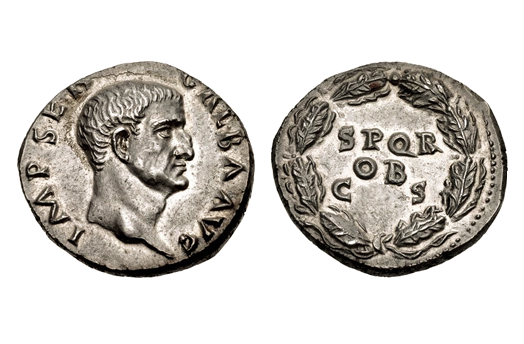
about ancient nomos
Ancient Nomos Art is a museum of galleries exhibiting ancient coins and ancient mint maps. The coin gallery displays the diverse art and history of hand-crafted ancient Greek, Roman, Byzantine, Persian and Medieval coinage. The ancient mints mapping gallery features Greek, Roman, Byzantine, Asia Minor and Medieval mint city regions and territories. Visitor's are welcome to explore, study and enjoy Ancient Nomos Art.

Imperial, Roman – 68 AD
Servius Galba
From Ancient Galleries

Obverse: IMP SER GALBA AVG, Bare head bust of Emperor Galba facing right.
Reverse: Legend: S P Q R / O • B / C S, in three lines within an oak wreath.
LEGEND
Obv: IMP SER GALBA AVG, Bare head bust of Galba facing right. Rev: S P Q R / O • B / C S, in three lines within an oak wreath.
The Roman Governor/General Galba reigned as emperor for only seven months, from June 10, 68 AD, following Nero’s death, to January 15, 69 AD. Galba’s reign marked the official end of the Julio-Claudian dynastic reign of Roman emperors. With the help of Galba’s army in Spain, he quickly acted upon Nero’s death to fill the void as emperor. Galba was born Servius Sulpicius Galba into an aristocratic family on December 24, 3 BCE. His father was Gaius Sulpicius Galba and his mother was Mummia Achaica. Galba was thought to have been a child prodigy and intelligent youth, as noted by historian Suetonius in his The Twelve Caesars. Suetonius notes that Emperor Augustus singled Galba out of a group of young boys as having potential for great leadership qualities. Galba’s only formal marriage – since he was thought to have been a homosexual – was to Semilia Lepides. As a young adult, Galba was respected by the Julio-Claudian Roman leaders as having remarkable abilities, enabling him to eventually becoming Roman Army commander in Gaul in 40 AD, then as governor of Africa from 44 – 45 AD, and following a request by Nero, became the Roman governor of Spain in 60 AD. After eight years as governor of Spain, Galba dropped the title and assumed the new title of Caesar following the death of emperor Nero. Unfortunately, Galba’s greed and spite toward the wealthy quickly made him an unpopular emperor. As emperor, Galba demanded tribute money from many of Rome’s towns, seized money from rich Romans and failed to give additional money to his legions and troops. Instead, Galba kept the money for himself. After Galba lost much of his support from his military and guards, his rival Otho plotted and bribed the Praetorian Guards to have Galba executed while he was in the Roman Forum. Galba’s assination took place on January 15, 69 AD, after having served as emperor for less than seven months. Otho was quickly declared the new Roman emperor. Galba’s short reign marked the first in a succession of leaders known as ‘the year of the four Roman emperors.’ The obverse of this denarius depicts a bold and powerful portrait bust of Emperor Galba, skillfully engraved and artfully executed in the finest of Roman realism. The coins reverse depicts the legend SPQR, which is an abbreviation for the ancient Republican Roman Latin phrase Senātus Populusque Rōmānus (“The Roman Senate and People of Rome”), referring to the Republican government in which Roman society believed all authority came from the people of Rome. The SPQR Republican tradition was carried into the Imperial period, but was used by emperors more for propaganda rather than the original political ideal of the Senate as Roman citizenship representation.
DOCUMENTATION
Value: Denarius. Metal: AR Silver. Weight: 3.35 grams. Mint: Rome. Date: Struck circa June 10, 68 AD – January 15, 69 AD.
Attribution: Roman Imperial Coinage I, 241, 167; BN III, Paris, 41, 76-7; BMCRE 34 (incorrectly attributed as laureate bust); RSC 287. Photo Courtesy Classical Numismatic Group.
Legend, Documentation and Attribution
